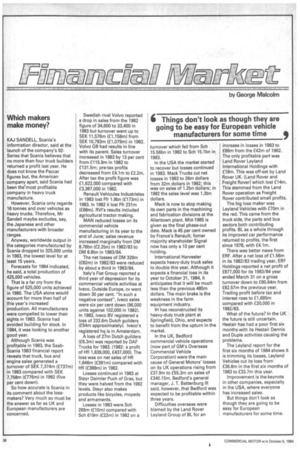Which makers make money?
Page 42

If you've noticed an error in this article please click here to report it so we can fix it.
KAJ SANDELL, Scania's information director, said at the launch of the company's 92Series that Scania believes that no more than four truck builders returned a profit last year. He does not know the Paccar figures but, the American company apart, said Scania had been thdmost profitable company in heavy truck manufacture.
However, Scania only regards 16 tonnes and over vehicles as heavy trucks. Therefore, Mr Sandell maybe excludes, say, the Japanese and other manufacturers with broader ranges.
Anyway, worldwide output in the categories manufactured by Scania dropped to 325,000 units in 1983, the lowest level for at least 15 years.
Forecasts for 1984 indicated, he said, a total production of 425,000 vehicles.
That is a far cry from the figure of 525,000 units achieved in 1980. The USA alone would account for more than half of this year's increased production. All manufacturers were compelled to lower their sights in 1983. Scania had avoided building for stock. In 1984, it was looking to another good year.
Although Scania was profitable in 1983, the SaabScania 1983 financial report reveals that truck, bus and engine sales generated a turnover of SEK 7,374m (£737m) in 1983 compared with SEK 7,758m (£776m) in 1982 (five per cent down).
So how accurate is Scania in its comment about the lossmakers? Very much so must be the answer as far as UK and European manufacturers are concerned.. Swedish rival Volvo reported a drop in sales from the 1982 figure of 34,600 to 33,400 in 1983 but turnover went up to SEK 11,576m (£1,158m) from SEK 10,793m (£1,079m) in 1982. Volvo GB had results in line with its parent. Sales turnover increased in 1983 by 13 per cent from £115.9m in 1982 to £131.5m; pre-tax profits decreased from £4.1m to £2.2m. After tax the profit figure was €1,622,000 compared with £3,387,000 in 1982.
Renault Vehicules lndustrieles in 1983 lost Ffr 1.9bn (£173m) in 1983. In 1982 it lost Ffr 231m (£68m). RVI's results included agricultural tractor making.
MAN reduced losses on its commercial vehicle manufacturing in its year to the end of June; sales revenue increased marginally from DM 8.78bn (£2.2bn) in 1982/83 to DM 8.8bn in 1983/84.
The net losses of DM 329m (E62m) in 1982/83 were reduced by about a third in 1983/84.
Italy's Fiat Group reported a third year of depression for its commercial vehicle activities at lveco. Outside Europe, cv went down 30 per cent. "In such a negative context", lveco sales were six per cent down (96,000 units against 102,000 in 1982). In 1983, Iveco BV registered a loss of 232.6m Dutch guilders (£54m approximately). lveco's registered hq is in Amsterdam.
A loss of 27m Dutch guilders (£6.3m) was reported by OAF Trucks for 1983. (1982: a profit of Hfl 1,839,000, £437,000). The loss was on net sales of Hfl 1,646m (£391m) compared with Hfl (E388m) in 1982.
Losses continued in 1983 at Steyr Daimler Puch of Gras, but they were halved from the 1982 levels. Steyr also makes products like bicycles, mopeds and armaments.
Losses in 1983 were Sch 289m (£10m) compared with Sch 619m (£22m) in 1982 on a




























































































































































